Prague Old Town – Praha Staré MÄ›sto, Prague New Town – Praha Nové MÄ›sto and Prague Lesser Town – Praha Mala Strana are the areas of the city where most chain hotels are located and the area where most tourists will likely concentrate their activities.
I had not stayed in an Old Town hotel before due to their generally higher expense and the higher cost of restaurants and beer in Old Town. This past week I stayed six nights at Clarion Hotel Prague Old Town (my review) and spent about half my time walking around in the Old Town area of Prague and half the time exploring other areas of the city.

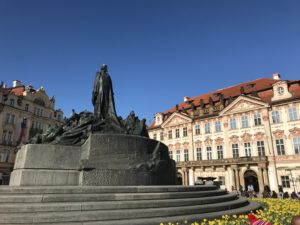
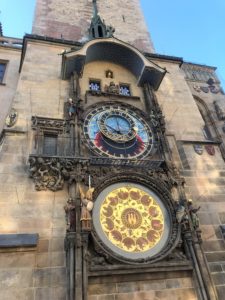
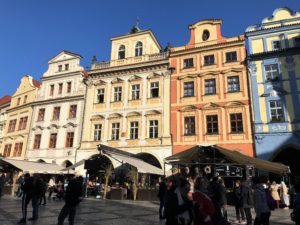
Prague Old Town Square and the alleys leading to Charles Bridge tend to be the most crowded streets in the city. These streets and squares have beautiful architecture and many of the primary tourist sites. These areas of Old Town are also the places you find yourself literally in a crowd of wall to wall tourists walking alleys in peak season.
Our time in the first week of April 2019 had some of the smallest crowds we experienced in areas of Old Town and crossing Charles Bridge. Since most of the restaurants and pubs I am most familiar with are on the opposite side of Old Town than Clarion Hotel Old Town Prague, we traversed the square many times.
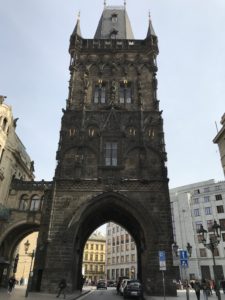
I was happy to have snapped lots of photos of Old Town Square on Monday since we walked through the square on Tuesday to find Easter festival food carts on the square in preparation for the following weekend.
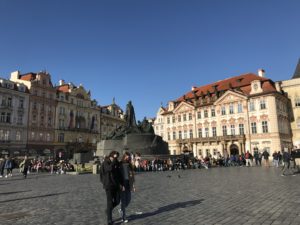
Jan Hus Memorial in Old Town Square is the main feature in the large space of the square. Over the past few years I have come to realize how significant Jan Hus (1369-1415) is to Czech history in what I imagine is Czech identity of self determination developed centuries ago. Might just be my romantic projections onto a cultural identity. I actually have little knowledge on Czech identity.
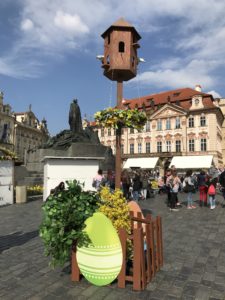
Jan Hus was educated at Charles University Prague as a theologian and became a priest in 1400. Early on he preached church reform and provided sermons in Czech at Betlémská kaple/Bethlehem Chapel Prague. As a supporter of ideas and the writings of the English theologian John Wycliffe (1320s-1384), Jan Hus’ teachings put him in confrontation with leaders in the Roman Catholic Church. Jan Hus was burned at the stake in 1415.

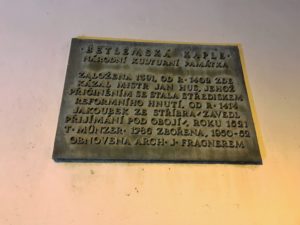
His followers were Hussites and they became a powerful religious movement throughout Bohemia, Moravia and Silesia to the extent that Papal crusades against the Hussites led to the Hussite Wars (1420-1434). These events were significant church reform forerunners established in Central European culture a century prior to Martin Luther and the Protestant Reformation.
Restaurace U Betlémské kaple
Turned out I spent several hours around Betlémská kaple/Bethlehem eating dinner a couple of times at Restaurace U Betlémské kaple. Had absolutely no idea there was a connection between Jan Hus and Betlémská kaple and the name of the restaurant I dined at for hours on our trip. Those are the kinds of connections I find fascinating about travel when I learn more about a place after I have return home, while wandering the streets of travel memories from my armchair and bed.
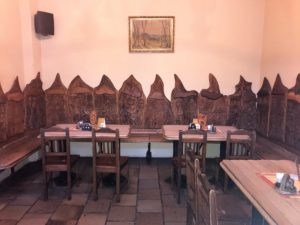
We wondered why they did not have cushions for the wood benches in the restaurant. Now that I realize U Betlémské kaple is a restaurant named for the church where Jan Hus preached to the people in Czech over 600 years ago, hard wooden benches seem more fitting for dining in penance in the namesake to the historic medieval church.
Josefov, Praha 1 – Old Jewish Quarter, Prague 1
For years I wondered about the Old Jewish Quarter since I often saw it mentioned in travel guides and on some maps, but never noticed being in what seemed like the Jewish Quarter when I was walking around Old Town Prague. This trip I made a concerted effort to locate a street sign for Josefov, the historic Jewish Quarter of Prague that is surrounded by Stare Mesto/Old Town in Praha 1.
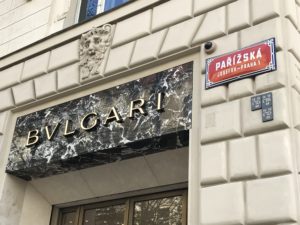
Josefov has many luxury brand shops and beautiful Art Nouveau architecture. The historic Jewish quarter was mostly demolished in the 1890s/1900s when a grand city plan restructured Prague’s city center.
https://en.wikipedia.org/wiki/Josefov
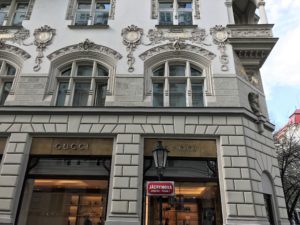
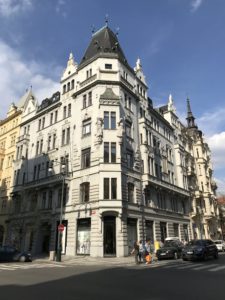
One of the areas we visited on our trip in Prague was a tram ride to OlÅ¡any Cemeteries, Prague’s largest cemetery area including the New Jewish Cemetery in Žižkov, Prague 3. The Jewish cemetery was established in 1890.
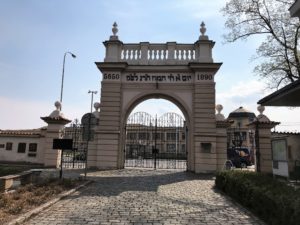
One of the unsettling observations in the New Jewish Cemetery are the high proportion of graves mentioning family members who died in Nazi concentration camps.
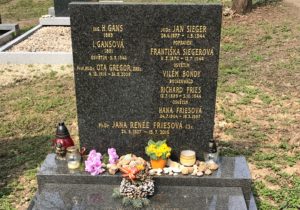
Of approximately 118,000 Jews in Bohemia and Moravia (present Czech Republic) in the 1930 census, about 78,000 were killed and about 14,000 survived the war. Others were able to emigrate prior to and during the war.
Sitting on a bench across from the Franz Kafka Statue, a tour group came by and stopped near where we were sitting. The English speaking guide spoke of the historic wall that had existed around the ghetto. He stated the Franz Kafka statue is near the point where the wall bordering Josefov once stood. Franz Kafka was born in the Jewish Quarter of Prague.
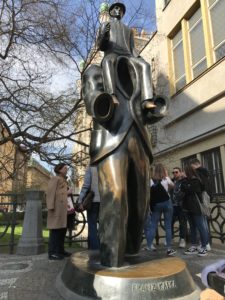
There is a lot of history to see and learn walking around Prague Old Town. Each trip I discover a little more to better acquaint me with this city.




1 Comment
Comments are closed.